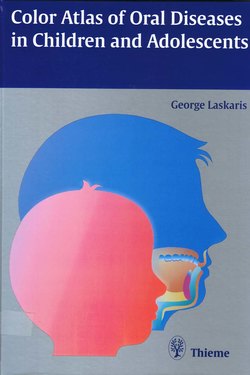Читать книгу Color Atlas of Oral Diseases in Children and Adolescents - George Laskaris - Страница 15
На сайте Литреса книга снята с продажи.
Оглавление6 Periodontal Diseases
Gingivitis
Definition
• Gingivitis is an inflammatory disease of the marginal gingiva, either localized or generalized.
Etiology
• It is primarily caused by bacterial plaque accumulation due to inadequate oral hygiene.
• Calculus, mechanical irritation, and irregularities in the position of the teeth may be contributory factors.
Occurrence in children
• Common.
Localization
• Free and interdental gingiva. Mainly observed during the mixed dentition, and more rarely in the primary dentition.
• Sometimes in areas of tooth eruption (eruption gingivitis).
Clinical features
• Redness and edema, usually without pain (Fig. 6.1).
• Gingival hyperplasia may sometimes be observed (Fig. 6.2).
• Bleeding may occur spontaneously, or after light probing.
• There is often halitosis.
• The diagnosis is made clinically.
Differential diagnosis
• Desquamative gingivitis
• Drug-induced gingival hyperplasia
• Gingivitis due to mouth breathing
• Acute leukemia
Treatment
• Plaque control and good oral hygiene.
• Gingivectomy, in cases of severe gingival hyperplasia.
Periodontitis
Definition
• Periodontitis is the result of progression of the inflammatory process from the gingiva to the deeper periodontal structures.
Etiology
• Bacterial plaque is important for the initiation of the disease.
• The same factors as in chronic gingivitis, which usually evolve into periodontitis.
• Systemic predisposing factors include: diabetes mellitus, human immunodeficiency virus (HIV) infection, immune diseases, metabolic diseases, etc.
• Host factors are also important, and appear to be influenced by genetic and environmental factors such as smoking.
Occurrence in children
• Rare, mainly in adolescents.
Localization
• Localized or generalized.
Clinical features
• The consequences of periodontitis are alveolar bone resorption and loss of attachment, followed by periodontal pocket formation.
• Inflammation and edema of the gingiva, pockets deeper than 3 mm (Fig. 6.3).
• Bleeding and malodorous breath, teeth migration, tooth movement.
• The diagnosis is usually made clinically.
Radiographic features
• Alveolar bone resorption.
Differential diagnosis
• Papillon–Lefèvre syndrome
• Langerhans’ cell histiocytosis
• Acatalasia
• Hypophosphatasia
• Leukemia
• Glycogen storage disease Type Ib
• Scurvy
Treatment
• Plaque control and good oral hygiene.
• Scaling and root planing and/or surgery.
• Maintenance therapy is very important.
Fig. 6.1 Chronic gingivitis
Fig. 6.2 Chronic hyperplastic gingivitis
Fig. 6.3 Periodontitis
Juvenile Periodontitis
Definition
• Juvenile periodontitis is a specific type of early-onset periodontitis, which usually affects adolescents, and is characterized by severe alveolar bone loss.
Etiology
• Actinobacillus actinomycetemcomitans and probably other pathogens may be involved.
• Reduced immune response to endotoxins of bacterial plaque or genetic immune insufficiency have been proposed.
Occurrence in children
• Only in adolescents.
• Familial occurrence.
Localization
• Affects only permanent teeth.
• Localized or generalized.
• Selectively affects incisors and first molars.
Clinical features
• Mild gingival inflammation (Fig. 6.4).
• Rapid and severe destruction of alveolar bone.
• Deep periodontal pockets, bleeding, malodorous breath.
• Absence of local factors (bacterial plaque, calculus).
• Tooth mobility and migration (Fig. 6.5).
Radiographic features
• Severe and rapid bone loss (Fig. 6.6).
Differential diagnosis
• Prepubertal periodontitis
• Adult periodontitis
• Papillon–Lefèvre syndrome
• Ehlers–Danlos syndrome, type VIII
• Crohn’s disease
• Chediak–Higashi syndrome
• Ulcerative necrotizing periodontitis in HIV infection
• Langerhans’ cells histiocytosis
• Glycogen storage disease Type Ib
• Cyclic neutropenia and agranulocytosis
• Juvenile diabetes mellitus (type I)
• Down’s syndrome
Treatment
• Conservative mechanical treatment or surgery.
• Systemic antibiotics, local antiseptics.
Desquamative Gingivitis
Definition
• Desquamative gingivitis is a relatively common clinical manifestation of various mucocutaneous diseases on the gingiva (a non-specific disease entity), with a well-defined clinical pattern.
Etiology
• The most common disorders that cause desquamative gingivitis are cicatricial pemphigoid, lichen planus, bullous pemphigoid, pemphigus, linear IgA disease and, rarely, other mucocutaneous diseases.
Occurrence in children
• Very rare.
Localization
• Buccal anterior gingiva of the maxilla and mandible.
• Usually localized and rarely generalized.
Clinical features
• Red gingiva, edematous with erosions (Figs. 6.7, 6.8).
• Characteristic desquamation of the epithelium or bleeding bullous formation after rubbing with the spatula.
• Painful gingiva during mastication and brushing.
• Rarely, bleeding. The disease has periods of remission and exacerbation.
• Searching for other signs and symptoms of the underlying disease is important for the diagnosis.
Laboratory examinations
• Histopathological examination.
• Direct immunofluorescence.
• Indirect immunofluorescence.
Differential diagnosis
